Hindu College – 125 Years of Excellence – A Retrospective and Celebration
“Hindu College endeavors to nurture students with a keen analytical and scientific bent of mind with a sensitivity to their responsibilities and human values so that they are amongst the best citizens of India.”
(College Manual 01, Clause 2)
The Core Vision and Mission – Dedication to Producing Complete Citizens
Founded in 1899, Hindu College has a storied past that binds it closely to the nation, and to the city of Delhi. The idea of the college was born from the Indian movement for independence, which was growing in strength as the nineteenth century drew to a close. A little more than a decade earlier, the Indian National Congress had been established; in this year, the first party constitution was framed at the historic Lucknow session. In 1899, Mahatma Gandhi was in South Africa, and was succeeding in his early campaign against efforts to disenfranchise the Indian community there. DadabhaiNaoroji was two years from publishing Poverty and Un-British Rule in India. BalGangadharTilak had uttered his now-famous demand for Swaraj as a birth-right.
Against this backdrop of gathering nationalist energies, certain prominent citizens of Delhi, notably LalaShriKrishanDassjiGurwale, were committed to starting an institute which would impart higher education to the youth. Dedication to the nation, non-elitism, and non-sectarianism were built into the very foundation of Hindu College, and remain the core of its ethos. LalaKrishanDassji came from a family that treasured legends of how its ancestors sacrificed their wealth as penalty for aiding the revolutionary forces in 1857. Having himself seen the economic hardships of the great famines of 1886 and 1889, he was deeply concerned by economic inequities in access to education, as well as the lack of nationalist commitment in the pedagogies of the many prestigious Indian colleges. His ideal of a national college centered on fees low enough to be afforded by the underprivileged classes, and a syllabus and teaching informed by a liberal and humanist ethos and nationalist commitment. The inauguration of its first, small premises in a hired building in Kinari Bazaar, ChandniChowk, was at the hands of Pt. Madan Mohan Malviya on the traditional first day of spring, BasantPanchami. The first body of students numbered only thirteen. The air of this long-ago spring day in the heart of Old Delhi, in sight of walls already two centuries old, and presided over by a dedicated patriot and educationist, seems to still float through the Hindu College campus and inspires its vision of the future.
By the time of the inception of Delhi University in 1922, Hindu College had grown from its modest beginnings. Indeed, the two institutions and many other landmarks of the North Campus have intimate ties from their early years—when the Faculty of Law was proposed in 1923, the governing body of Hindu College put their hall at the disposal of the University for lectures in law. This hall would have been in the College’s second home, in Kundenwalan (Ajmeri Gate area), and many stories from this phase in its history bind it even more strongly with the national struggle. Around 1902, the student body of the College numbered almost a hundred, and could not be accommodated in the ChandniChowk building. Its founder, ShriGurwale, persuaded one of Delhi’s most illustrious citizens to donate a site for its expansion—RaiBahadur Sultan Singh, whose Kashmere Gate residence hosted meetings of the Congress Working Committee, as well as key leaders from Mahatma Gandhi to MotiLal Nehru and Sarojini Naidu. His generosity links Hindu College to other institutions for educational and social welfare institutions that are landmarks of Delhi, for instance, his equally philanthropic son founded the Modern School.
In addition to more extensive facilities for teaching, the new site was a part of Delhi’s political landscape, and formed yet another link between the history of the College and the cultural past of the city. Before becoming a centre for the Indian national movement under RaiBahadur Sultan Singh, it had been part of the property of Coloner Skinner (‘Sikandar Sahib’), the famous East India Company officer, who also built the St. James’ Church or Skinner’s Church that stands nearby. The College building chanced to stand between a mosque and a church, a beautiful metaphor for its allegiance to a multicultural Indian society. ‘Old Hindu College’ as the site is still known today is an indispensable part of heritage walks and histories of Delhi. During this phase of its growth, the College did not swerve from its focus on affordable and ideologically rooted education. Despite severe financial crises, the fees remained low, and its founder LalaKrishanDassji made regular donations to its maintenance, which ultimately totaled Rs. 45,000: a personal testament of his faith in, and commitment to, the future of the fledgling college. The staff, too, enacted the nationalist spirit of collective donation of work and self-sacrifice by refusing to draw their salaries for as long as the College was in difficulties, and by carrying out door-to-door campaigns to collect donations. In these times, the academic work of the college and the self-improvement of its students did not flag; indeed the college magazine Indraprastha was started in 1916 as a quarterly.
“I am happy to see that Hindu College has students of all castes and creeds. Men outside who break one another’s heads have gone mad. Students should set an example to other leaderss...”
— Mahatma Gandhi, Speech at Hindu College, 2 November 1929
By 1925, the College had regained its financial stability and had consolidated its gains far enough to move to a second building in Kashmere Gate. It now had about 700 students. This enlarged student body was now served by new buildings and facilities including a library, a laboratory and a small hostel. It is noteworthy that Hindu College was (as it still remains) ahead of the times in its social consciousness, with admissions open to students of both genders and any religious affiliation.
It was in the historic site of Kashmere Gate that the Hindu College student community experienced a great upsurge of social commitment and political consciousness. This is witnessed to by the roll of towering intellectuals who were invited to address them. Pt. Malaviya, the Mahatma, Jawaharlal Nehru, LokmanyaTilak, Annie Besant, RabindraNath Tagore, Subhash Chandra Bose, Sarojini Naidu, and Muhammad Ali Jinnah are among those whose exhortations forged and honed its collective will. Sadly, given the perils of opposing British imperialism in this period, especially for students of an already-suspect nationalist institute, an inevitable secrecy shrouds much of its alumni’s activities during this period. Recent research into the history of the college has revealed, however, that the great revolutionary Chandrashekhar Azad and some of his associates were helped to lie in hiding at the College hostel, in the Civil Lines area. While it was still young as institutions go, in the 1920s and 1930s, its students had borne witness to the JallianwalaBagh massacre, the First World War, and the unification of millions in the Swadeshi movement. That such students, whose first steps in higher education were taken in classrooms dedicated to nationalism, would come of age as young patriots in the vanguard of the struggle seems inevitable.
The small family of teachers and students did not confine their commitment to swaraj(self-determination) to acting against the British, outside the campus. Internally, this commitment became the core of its pedagogy, decision-making structure, and philosophy. It instituted the Parliament of the Republic of Hindu College in 1935, a structure of internal democracy rather than didactic authority, which till today is unique among institutions of higher learning in Delhi and even in the country. Hindu College did not merely play audience to the debates and meditations of the celebrated thinkers and activists who spoke at its historic amphitheatre in the Kashmere Gate premises. Its students organised themselves into a community around a constitutional document framed in the finest traditions of self-governance. Through this structure it prepared citizens for the national Republic that was yet to come, not only through the theory of freedom, but also its practices of suffrage and parliamentary debate. Indeed, many of the national leaders named above, including Gandhi, Bose, MotiLal and JawaharLal Nehru, and others visited the College Parliament and encouraged its project. One of the earliest issues of Indraprastha available in the College archives today shows ‘Bharat Mata’ framed by the map of India, flanked by two lions and with the slogan ‘VandeMataram’ lettered across. This frank display of nationalist imagery stands as a sign of how deeply and openly committed the Collegecommunity was. This issue also reported Mahatma Gandhi’s visit to the College and the text of his address. Given its exceptional system of participatory democracy, enabling self-actualisation and agency, it is no surprise that Hindu College was the intellectual cradle of many leaders of the national struggle and revolutionary freedom fighters.
In the last phase of the national movement, the teachers and students of Hindu College proved their mettle and the real value of their educational and parliamentary system in answer to Mahatma Gandhi’s ‘Quit India’ call in 1942. Many even went to prison for opposition to the imperial state. At this key historical moment, the institution as a whole played a signal role by taking the deeply symbolic resolution to remain closed for several months, rightly subordinating its task of teaching to its dedication to the national cause. The rich history of the men and women the College has sent forth into India’s service is still being explored, and their collective contribution to India cannot be gainsaid.
It bears remembering that the College as a nationalist institution, and as one dedicated to academic excellence, was not divided in its aims—from the birth of national consciousness, education had been given the highest importance as a part of colonial policy as well as of resistance to it. From the time of the imposition of English in 1835 as the medium of education in Indian schools, the ideal of education that would be nationalist as well as modern, and would fashion conscious and dedicated citizens who were also contributors to the global community, had occupied the best minds of India. Schools and colleges run by the British state were rightly seen as inimical to the Indian youth, and every phase of the struggle from the Swadeshi and boycott movements to the Khilafat and Non-Cooperation movements, struck at these factories of imperialism. The establishment and flourishing of Hindu College and its ilk were the necessary, constructive part of this resistance. In a sense, every student Hindu College educated was a blow struck for a truly independent India. It is a testament to the vision of its founders that Hindu College had already been working for more than fifteen years when (around 1916), prominent reformers led by Mrs. Annie Besant began trying to establish a “national system of education” (standing apart from the government and missionary systems). By the time these efforts fructified into the Delhi University, many colleges like Hindu could join under it as valuable contributors.
As one of the oldest, and already well-known, constituents of the Delhi University, Hindu College arrived in the era of independent India with student body, teaching staff, and facilities that had steadily grown since its birth. In 1947, it signified its continued commitment to internal as well as national democracy, and the adaptability and contemporaneity of its vision, by amending the Constitution of its student Parliament in consonance with the Indian Constitution-in-the-making. In 1953, having developed beyond the capacities of its Kashmere Gate premises, the College moved to its present location in the heart of the University’s North Campus. Today, its brick-red facade framed by wide lawns and flowerbeds is among the enduring and iconic images of Delhi as a centre of education. The building is protected as a part of the city’s heritage, recognised as having “historic significance, historic integrity, and historic context” as explained in policy guidelines of the CPWD (Central Public Works Department) and the ASI (Archaeological Society of India). From its inauguration in a dharamshala in ChandniChowk, through its history in Kashmere Gate which will be remembered as a part of India’s awakening to freedom, to its years of service to the ideals of higher learning and good citizenship from the historic North Campus site, Hindu College has been a landmark in the time and space of the national capital. Nevertheless, its great prestige and its awareness of a treasured and distinct culture are based on turning not to the past but to the future. Its founding vision guides it, and centers the long continuity of its ethos—and part of this founding vision is attention to, and harmony with, the real and present national and global communities.
Perspective Plan (Vision 2030)
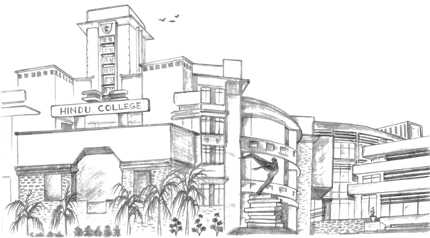
Introduction
Poised at the threshold of 125 years of its existence, Hindu College, which started with thirteen students and six teachers in 1899, has now grown into one of the most coveted higher education institutions in the country with more than 4,000 students and 200 teachers, offering undergraduate courses in 19 disciplines and post-graduate programmes in 14 disciplines in humanities, science, and commerce. Today, Hindu College holds an exemplary position amongst the various educational institutions in our country. The college secures top rankings in India Today College Rankings and is placed 2nd in NIRF.
The institution is driven by a quest for excellence articulated in the vision, mission, goals and core values. The Internal Quality Assurance Cell (IQAC) leads the quality assurance and quality enhancement of educational processes at the institution. The IQAC presents the Institutional Perspective Plan (Vision 2030), the plan of the institution which began its journey more than a decade ago which has been further updated in line with NEP 2020.
The major thrust areas include curriculum development, research industry-academia collaborations, student capability enhancement, infrastructural upliftment, sustainable green initiatives and quality assurance and enhancement for the holistic development of the institution.
Perspective Plan Committee
- Principal and chairman
- Vice-Principal and Vice-Chairman
- Co-ordinator, IQAC
- Nominated Heads of Department
- Nominated Faculty Members
- Librarian
Perspective Plan for Research aligned with the mandates of NEP 2020
The National Education Policy (NEP) 2020 envisages a robust research ecosystem and lays the framework for promoting research and innovation. Development of a full-fledged Research Centre in the college is a project that was envisioned a few years back, around 2019, wherein the construction of a four storeyed building began with the ultimate aim of promoting research and fortunately a huge support was received by donors like Relaxo which helped in the development of the civil structure while NBCC played a crucial role in the strengthening of the labs. This has been termed as the state-of-the-art Research Center scrolling 38000 sq feet area, having a high end 20 well equipped science research labs that will further the work in various multifaceted areas such as Material Science, Nanomaterials, Social Sciences, Environmental Sciences, Green Chemistry etc., Himalayan Studies, special adjunct faculty guest rooms and a 250 capacity auditorium for academic purposes. The labs in the research centre are housing diversity of sophisticated instruments such as FTIR, ED-XRF, GC, GC- MS, Tunable light source, Rotor-evaporators, UV-VIS Spectrophotometer, CO2/O2 incubation, stability chamber, environment chamber, spin coater etc.
The institute has the Green Chemistry Network Centre which is working for the popularization of Green Chemistry in India and for doing so is organizing series of International as well as National workshops, conferences, seminars and most importantly conducting high quality research in Green Chemistry, Catalysis and Nanotechnology- the areas which have seen nobel prize winners in the recent decades. The research has created a global impact and won accolades in the form of highly cited researchers and publications in top ranking journals including Chemical society Reviews, Green chemistry, Materials Horizons, Dalton Transactions, Coordination Chemistry Reviews etc.
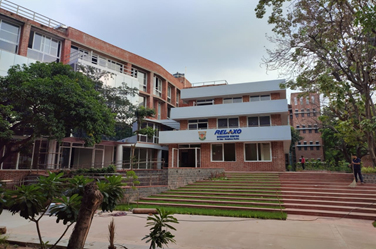
State of Art Research Centre, Hindu College, University of Delhi
As per Vision 2030, following perspective plans have been proposed:-
- Increased Academia-academia/industry Collaborations with recognized global institutes and leading industries
- More Start-up and entrepreneurship cells
- Networking with global green chemistry networks across the world
- Interdisciplinary research with the aim to accomplish the 2030 Agenda of Sustainable Development Goals
- Set-up of Sophisticated analytical facilities that can cater to the demands of various industries and academic institutes
- Increased research grants to be provided to the aspiring faculty and students
- Increased Internships, Apprenticeship, projects and community outreach
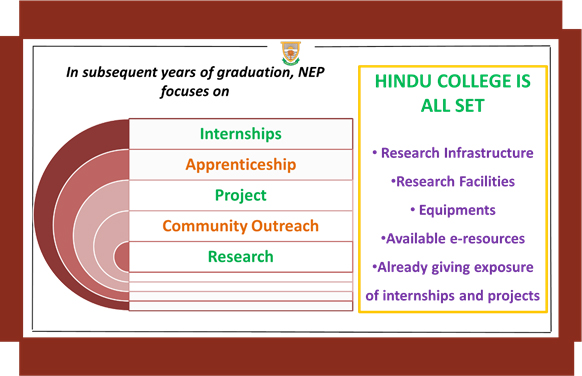
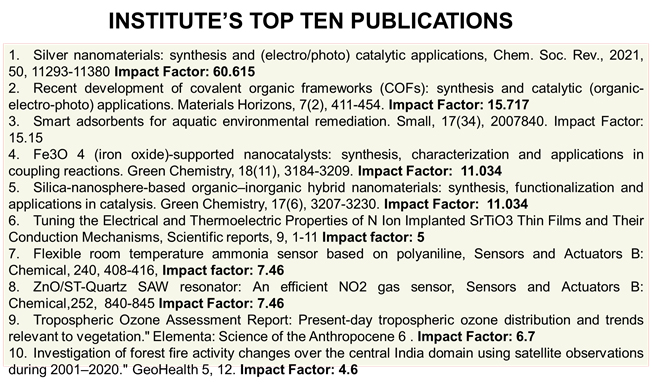
Perspective Plan for Curriculum Development
As per vision 2030, following plans have been proposed for the curriculum development:-
- Increased emphasis on experiential learning with the aid of latest innovative tools and techniques.
- Introduction of value added courses/add-on courses that impart skills and knowledge to the students beyond the curriculum to be explored by all the departments.
- Increased investment in resources for development of custom designed software packages for Enterprise Resource Planning (ERP).
- Introduction of innovative programmes at the undergraduate as well as post-graduate level which would be catering to the current industrial and societal needs
- Integration of skill development in all the programmes and courses so as to increase employability and nurture the entrepreneurship skills.
- Special emphasis would be directed towards integrating various components of Sustainable Development Goals in the curriculum of the various programmes offered by the institute.
- A well-structured outcome based curriculum would be followed in accordance with UGC guidelines.
- Development of a learning management platform for the creation of an open educational resources.
- Library Expansion which would provide easy access to digital knowledge resources through DU
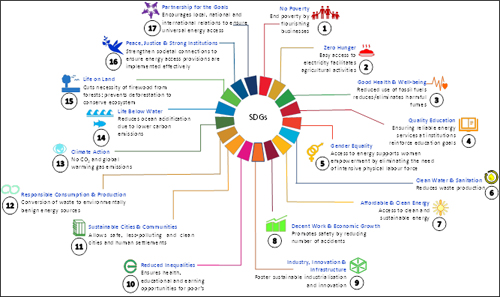
Curriculum development in line with the 2030 Agenda of Sustainable Development Goals (SDGs)
Perspective Plan for Student Capability Enhancement
Following plans have been proposed for the student capability enhancement:-
- Increased emphasis on fostering an ecosystem that will help in the development of the entrepreneurship skills of the students.
- Full support would be provided to the students for the establishment of start-ups in the campus for which an exclusive incubation centre with mentoring support from the enterpreneurs will be encouraged.
- Increased opportunities would be provided for the students to train them for various competitive examinations.
- Experiential learning will be given more emphasis in all the courses
- The institute already has an innovation cell and skill centre to enhance the student creativity and innovation. Due efforts would be required to further enhance the outputs of these centres.
- Interdisciplinary learning will be promoted.
Perspective Plan for Faculty Development and Staff
Following perspective plans in vision 2030 have been proposed for overall faculty and staff development:-
- While making appointments/recruitments, the prime emphasis would be placed on research component apart from the academic merits.
- Enhanced support will be provided to faculty members interested in seeking additional qualifications as well as the research and consultancy.
- Faculty and staff training, orientation and refresher programmes shall be encouraged.
- The institute shall take due interest and impart information to its faculty members about various ongoing national and international fellowships.
- Institute shall provide increased benefits to those faculty who have done outstanding work in the area of research.
E-Waste Skill Centre at Hindu College
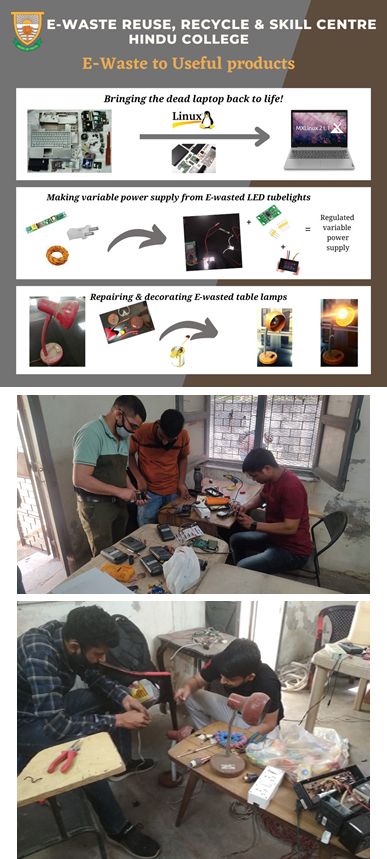
Collaborations
The institute had directed diligent efforts towards strengthening collaborative relationships with various academic as well as industrial institutes. Presently following research collaborative initiatives have been undertaken:-
- Ongoing Research Projects with leading Industries such as Ultra International Ltd, Reckitt Benckiser, Shri Ram Institute (SRI), TRI etc.
- DST funded projects have been awarded to the college which are running smoothly, with high funding.
- College is running several value added courses in collaboration with IIT Delhi which have theoretical as well as research components. The undergraduates are being trained and working on research projects on Green Energy (particularly, recovery of valuables from spent/waste lithium batteries using green techniques) and Hydrogels (Synthesis and insights into structure through spectroscopy).
- TRI (Translational Research & Innovations Pvt. Ltd): Hindu College has entered into close research collaboration with TRI which is a high potential start-up company, with authorized share capital of around Rs 1,000,000 focusing on Research and experimental development on natural sciences and engineering (NSE). The areas of technology co-development include Rare Earth Elements extraction from Coal dump sites, characterization of biodegradable polymers and natural colors. These projects have already been initiated and running successfully.

As per vision 2030, the institute has plans to develop and strengthen collaborative linkages with institutes of international and national caliber for student capacity enhancement, internships, placements, faculty enhancement and research.
Further, the institute intends to explore further opportunities for international student and faculty exchange.
Extension Services
Institute has the following extension services perspective plans:-
- Environmental initiatives (in line with Green Policy)
- Sustainability initiatives
- Educational Scholarships
- Support for physically challenged
- Community outreach programmes
- Skill Development programmes
Quality Assurance and Quality Enhancement (IQAC)
VISION
To make quality the defining element of higher education in India through a combination of self and external quality evaluation, promotion and sustenance initiatives.
MISSION
- To stimulate the academic environment for promotion of quality of teaching-learning and research in higher education institutions;
- To encourage self-evaluation, accountability, autonomy and innovations in higher education;
- To collaborate with other stakeholders of higher education for quality evaluation, promotion and sustenance.
- Commitment to quality has been a maxim of Hindu College since its very inception. The College has recently constituted the IQAC which commenced operations from July 2015 and which has now become the designated nodal agency for ensuring and providing quality guarantees in academics and administration of college. The IQAC has a diverse composition of alumni, parents, non-teaching staff, external experts and students.
Objectives of IQAC
The cell is envisaged to function as the hub for:
- Developing and disseminating standards of excellence in pedagogy and institution building.
- Providing a systematized and durable mechanism for conscious and continuing self-evaluation, introspection, and improvement in the overall performance of the College.
- Conceptualize, plan and implement quality initiatives and regularly evaluate the same.
- Providing a forum for students and alumni to participate in strengthening the academic standards of the institution. The cell shall receive and evaluate feedback from students, parents, alumni, and other stake holders as well as the society at large on an ongoing basis and strive to make quality consciousness an institutional paradigm.
Infrastructural Development
The College has made rapid strides in developing and upgrading its infrastructure in the last few years. The College has added a new Centre for Interdisciplinary Research, a state-of-the-art auditorium, a new academic block covering about 58,000 sq. ft. which includes science labs, lecture theatres, and seminar rooms, and a new amphitheatre named Utsav, built in the Romanic style, to its list of world-class facilities.
As per Vision 2030, the institute has plans to establish a state-of art world class library, new faculty blocks, more skill centres and continually work for the infrastructural upliftment aligned with modern requirements.
Hindu College's Vision 2020 — A Golden Future
Being a heritage site, the present academic building of the College had only limited possibilities beyond its capacity of 1500 students (after expansion work in 1960). The present strength requires large-scale upgrading of the campus, and for this purpose an Infrastructure Development Vision Plan (Vision 2020) has been formulated. Vision 2020 projects a student strength of over 4,500 after 2016.
One of Vision 2020’s chief priorities is provision of rooms for lectures, tutorials and laboratories. It has become imperative to have a larger academic block. This new block would offer the following advantages: 14 ‘smart classrooms’, 12 tutorial rooms, 8 department rooms, 4 lecture rooms, 4 laboratories, a staff room, and an office block. Its estimated cost is approximately Rs. 11.75 crores.
An equally urgent need is residential facilities for female students. At present the intake of the College is almost 50% female, with many of those admitted not being residents of Delhi. The female students’ hostel planned under Vision 2020 will provide accommodation for 168 students in 84 twin-sharing rooms. It is planned with up-to-date facilities and conveniences. The estimated cost for this hostel is approximately Rs. 12.25 crores.
The foundation stone for both the above buildings was laid on 28 March 2014 by the Hon’ble Lieutenant Governor of Delhi, Mr. Najib Jung. Both these prestigious projects are underway. Vision 2020 encompasses many other improvements to the campus, notably:
- Upgrading the auditorium. Though impressively large and with a history of its own, the auditorium is almost 50 years old and in need of refurbishment. The increasing population of students necessitates expansion of seating capacity and addition of modern technology. The estimated cost for these plans is approximately Rs. 5 crores.
- Adding a conference centre and guest house. The planned structures would offer state-of-the-art seminar and conference facilities. The guest house would have 8 residential rooms of a 3-star-hotel standard, to host visitors. These would greatly benefit student placement events, student executive training, and invitations to visiting faculty who can be offered accommodation. The estimated cost for these structures is approximately Rs. 15 crores.
- Research centre. In furtherance of Hindu College’s commitment to academic excellence, Vision 2020 also proposes building a research centre offering independent rooms, internet connectivity, and technologically current laboratories. The estimated cost for this is approximately Rs. 2 crores.